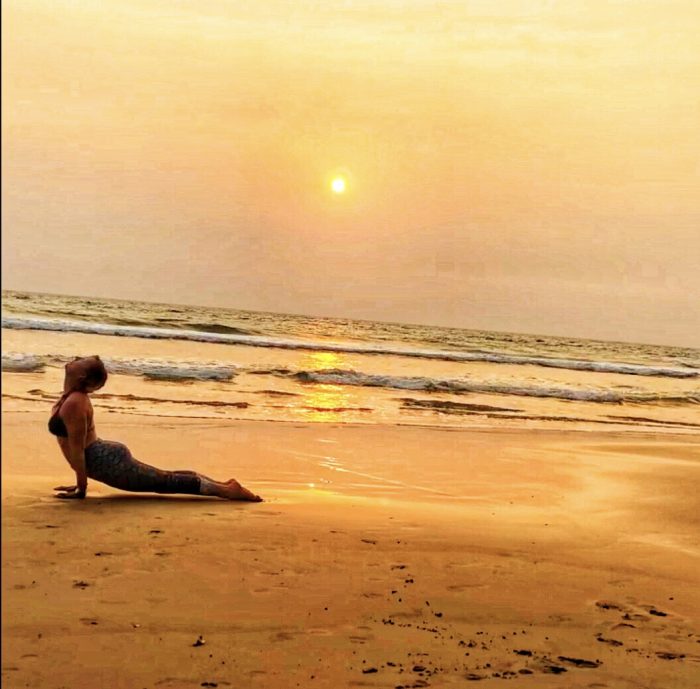“Here comes the sun ban-anan-a-nah here come the sun and I say its all right” (lyrics by the Beatles)
The humble sun salutation or suraya namaskar can be found in many styles of yoga asana practice. It’s quite often the first thing that someone new to the rubber rectangle will experience. Except if your sweating it out in a Bikrim 26, perhaps Bikrim thought he was above saluting the sun maybe he just didn’t want to add another 12 shapes to the series. I would have totally been down with it though just saying.
Surya Namaskar is part of a global yogi language, shared as asana practitioners around the world use the sequence as a warmup, to create heat in the body or as a functional transition to gently move into other asana as we breathe bend & flow. Or we take a Suraya Namaskar adventure to heights that challenge fitness, strength, creativity, flexibility & mobility. Suraya Namaskar has a little bit of everything, as an energising sequence that sees us stretch & yoke our mind, body breath & spirit to the corners of the universe and the four corners of our rubber rectangle.
She, Suraya or Ms Namaskar may seem simple, yet can be extraordinarily complex in its technical delivery. You can breathe & flow through it finding your sthira-sukham-aasanamor you can ad in handstands and jump backs until it becomes a cardiovascular workout form which we could probably measure someone’s VO2max or the maximum amount of oxygen that an individual can use during intense exercise & like so much about yoga today, it reflects both ancient ideas and modern innovation.
But from where did this bendy stretchy golden orb worshiping sequence come??
Our primary source of light is the sun, all life wakes & takes a siesta as she shines down Pacha Mama making her rounds. Since ancient times we humans have worshipped this golden giver of life. For thousands of years, Hindu people have worshipped the sun calling it Surya or “oka chakshus” eye of the world. Surya being both the physical and spiritual heart of our world and the creator of all life just like our hearts might be our own spiritual sun.
You remember that time someone in your life gave you that sit down on subjects to avoid like religion & politics … well you could probably add the Sun Salutation to that list of you are a yogerly inclined. Some schools of thought are that the sequence is at least 2,500 years old that it originated during Vedic times as a ritual prostration to the dawn accompanied by mantras, offerings of flowers and rice however there are some fairly significant arguments that point to the Sun Salutation was a more recent evolution.
The oldest-known yoga text to describe the Sun Salutation sequence, the Yoga Makaranda, was written in 1934 by T. Krishnamacharya, who is considered by many to be the father of modern hatha yoga. We don’t know exactly whether Krishnamacharya learned the sequence from his teacher Ramamohan Brahmachari or if he invented it himself. The text Vyayama Dipika or “Light on Exercise” illustrates athletic exercises for Indian wrestlers, including some that are pretty darn similar to Krishnamacharya’s version of Surya Namaskar which were then then point packed to the West in the 1920s or 1930s & this may explain why if you break it down the current sun salutation actually does look like a burpee….Krishnamacharya taught the sequence to his students, including K. Pattabhi Jois, B.K.S. Iyengar and Indra Devi who is recognized as the first Western woman to teach yoga around the world. It is these teachers who have inspired much of the practice in the West where Sun Salutations have become an integral part of our modern asana practice.
Christopher Key Chapple,Doshi Professor of Indic and Comparative Theology says
Surya Namaskar is nothing less than the embodiment of the Gyatri Mantra (and my favourite mantra) a sacred prayer to the sun. “As we sweep our arms up and bow forward, we honour the earth, the heavens, and all of life in between that is nourished by the breath cycle,” continuing with “As we lower our bodies, we connect with the earth. As we rise up from the earth, we stretch through the atmosphere once more, reaching for the sky. As we bring our hands together in Namaste, we gather the space of the heavens back into our heart and breath, acknowledging that our body forms the centre point between heaven and earth.”
As we breathe and bend our way through Suraya Namaskar it feels like a salutation to the divine, a source of light which allows us to let go of the darkness of our clouded mind. And although Sun Salutations can be practiced at any time of the day, the early-morning hours are considered especially auspicious for yoga asana and meditation practice. The hour just before sunrise is called Brahma muhurta “time of God” this is when the mind is supposed to be at its most calm & clear.
I invite you to imagine standing at the top of your rubber rectangle breathe, grounding your heals & feeling the energy rise from that grounded connection through to the top of the head. Deeply inhale and float your arms up over your head. Feel the familiarity the peace. Suraya Namaskar signals to that you can let go of what might be clouding your mind and drop into your asana practice. You cannot help but feel connected to the ritual of this sequence. I deeply respect this part of my practice for its gift of warmth, the opening of the physical body and the connection of the breath to the body stilling my mind as I move through my chosen variation of the sequence.
‘Follow, follow the sun, the direction of the bird the direction of love’ (lyrics by Xavier Rudd)
xxxkit











Read 0 comments and reply